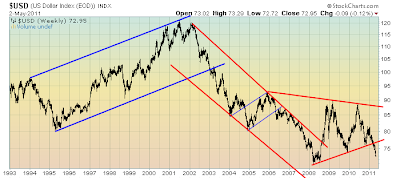As many are aware, Standard & Poors publishes earnings estimates for the S&P500. (My previous posts concerning their estimates can be found in the under the SPX Earnings Projections tag)
Currently, their estimates for 2011 add to the following:
-From a “bottom up” perspective, operating earnings of $98.06/share
-From a “top down” perspective, operating earnings of $94.89/share
-From a “top down” perspective, “as reported” earnings of $95.69/share
Currently, their estimates for 2012 add to the following:
-From a “bottom up” perspective, operating earnings of $111.79/share
-From a “top down” perspective, operating earnings of $101.21/share
-From a “top down” perspective, “as reported” earnings of $100.97/share
_____
I post various economic forecasts because I believe they should be carefully monitored. However, as those familiar with this blog are aware, I do not agree with many of the consensus estimates and much of the commentary in these forecast surveys.
_____
The Special Note summarizes my overall thoughts about our economic situation
SPX at 1331.10 as this post is written
Currently, their estimates for 2011 add to the following:
-From a “bottom up” perspective, operating earnings of $98.06/share
-From a “top down” perspective, operating earnings of $94.89/share
-From a “top down” perspective, “as reported” earnings of $95.69/share
Currently, their estimates for 2012 add to the following:
-From a “bottom up” perspective, operating earnings of $111.79/share
-From a “top down” perspective, operating earnings of $101.21/share
-From a “top down” perspective, “as reported” earnings of $100.97/share
_____
I post various economic forecasts because I believe they should be carefully monitored. However, as those familiar with this blog are aware, I do not agree with many of the consensus estimates and much of the commentary in these forecast surveys.
_____
The Special Note summarizes my overall thoughts about our economic situation
SPX at 1331.10 as this post is written


